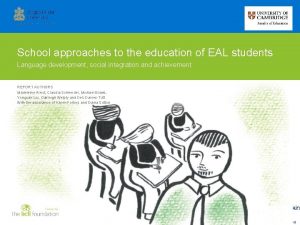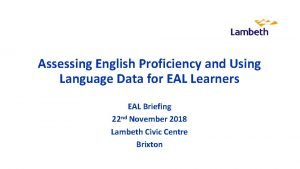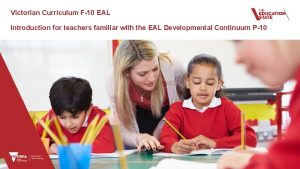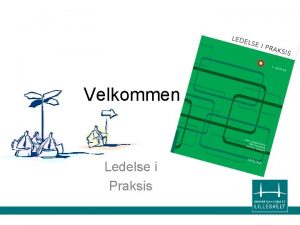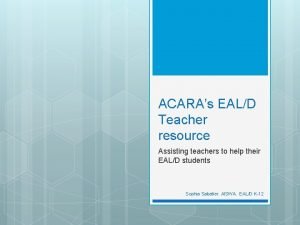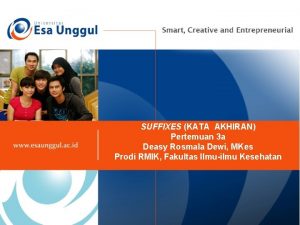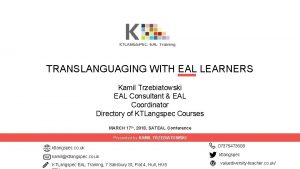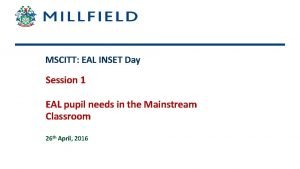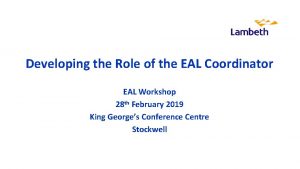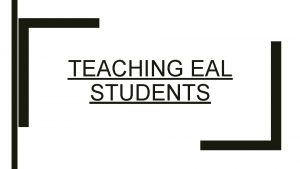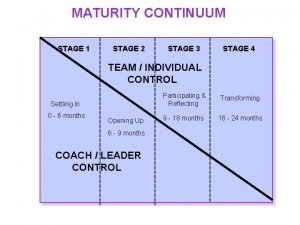Stage 2 English for EAL Students Assessment Design







- Slides: 7

Stage 2 English for EAL Students

Assessment Design Criteria Knowledge and Understanding The specific features are as follows: KU 1 Knowledge and understanding of ideas and perspectives in texts. KU 2 Knowledge and understanding of ways in which creators of texts use language features, stylistic features, and conventions to make meaning. KU 3 Knowledge and understanding of ways in which texts are created for different purposes, audiences, and contexts. Analysis The specific features are as follows: An 1 Analysis of ideas, perspectives, and/or aspects of culture represented in texts. An 2 Analysis of language features, stylistic features, and conventions, and evaluation of how they influence audiences. An 3 Analysis of similarities and differences when comparing texts. Application The specific features are as follows: Ap 1 Use of language and stylistic features to create texts that address the purpose, audience, and context. Ap 2 Use of evidence from texts to develop and support a response. Ap 3 Use of clear, accurate, and fluent expression.

Assessment Type 1: Responding to Texts (30%) Students produce three responses to texts. Two of the responses must be written, and one must be oral. Either the oral response or one of the written pieces may be replaced by a multimodal response. The texts on which the responses are based must be chosen from at least three of the categories listed below. One of the three responses could be a comparison of two or more texts from within or across these categories. The categories are: 1. an extended text such as a novel, a graphic novel, a collection of short stories, a biography, or other non-fiction prose text 2. a selection of poetry texts such as a poet study, anthology, theme study, song lyrics 3. a drama text or performance 4. a film or episode of a television miniseries 5. media texts from newspapers, magazines, radio, television, the internet, or other digital sources such as advertisements, talkback radio programs, technical articles, news presentations, sports reports, political commentary or cartoons, editorials, websites, social media, blogs, podcasts, or gaming. The written responses should total a maximum of 2000 words; the oral response should be a maximum of 6 minutes; a response in multimodal form should be of equivalent length.

Choosing Texts Novels - short but sophisticated Films – with obvious film techniques Of Mice and Men Life of Pi Tuck Everlasting Whale Rider The Pearl Crash Past the Shallows That Sugar Film I’m Not Scared 127 Hours The Messenger

Assessment Type 2: Creating Texts (40%) Students create written, oral, and/or multimodal texts for procedural, imaginative, analytical, persuasive, and/or different purposes. Students create: three texts one writer’s statement. At least one of the created texts should be written. Oral and/or multimodal forms are permissible. The three texts should total a maximum of 3000 words or equivalent.

Writer’s Statement Students produce a writer’s statement for one or more of the three created texts. In the writer’s statement they: explain and justify the creative decisions made in the process of writing one or more of their texts explain how they used language features, stylistic features, and conventions to meet the expectations of the intended audience(s) and achieve the stated purpose(s). Where the writer’s statement is for more than one created text, students may compare and contrast the choices they made to meet the expectations of the different audiences and/or purposes. The writer’s statement should be a maximum of 1000 words; an oral and/or multimodal writer’s statement should be of equivalent length.

Comparative Analysis Assessment Type 3: Comparative Analysis (30%) Students complete a written comparative analysis of two texts and evaluate how the language features, stylistic features, and conventions in these texts are used to represent ideas, perspectives, and/or aspects of culture, and to influence audiences. Must be written (up to 2000 words) A product of independent study, but teachers may advise and support
